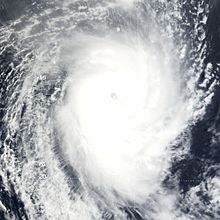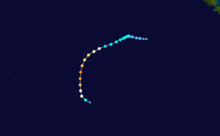- Cyclone Kamba
-
Intense Tropical Cyclone Kamba Intense tropical cyclone (MFR) Category 4 cyclone (SSHS) 
Cyclone Kamba on March 10 near peak intensity Formed March 5, 2008 Dissipated March 14, 2008 Highest winds 10-minute sustained:
185 km/h (115 mph)
1-minute sustained:
215 km/h (135 mph)
Gusts:
260 km/h (160 mph)Lowest pressure 930 mbar (hPa; 27.46 inHg) Fatalities None Reported Damage None Areas affected No land areas Part of the 2007-08 South-West Indian Ocean cyclone season Intense Tropical Cyclone Kamba (JTWC designation: 23S) was a powerful tropical cyclone which remained out over the open waters of the south-central Indian Ocean for its entire existence. The fourth and final intense tropical cyclone of the 2007-08 South-West Indian Ocean cyclone season, Kamba developed out of an area of disturbed weather just outside Météo France's area of responsibility on March 5. Over the next several days, the system intensified, becoming a moderate tropical storm, at which time it was named Kamba, late on March 8. rapid intensification followed shortly after with Kamba becoming an intense tropical cyclone around 1200 UTC on March 10. Shortly thereafter, the cyclone moved over cooler waters and into a less favorable environment. By March 12, Kamba rapidly degenerated into a remnant-low pressure area and dissipated two days later.
Contents
Meteorological history
On March 5, the Regional Specialized Meteorological Centre for the southwest Indian Ocean, Météo-France, began monitoring an area of disturbed weather located just outside their area of responsibility. At 0000 UTC, the system was classified as a tropical disturbance.[1] Operationally, Météo France did not begin issuing advisories on the disturbance until it had crossed 90°E.[2] Early on March 7, the Joint Typhoon Warning Center (JTWC) issued a Tropical Cyclone Formation Alert for the disturbance as they anticipated it to develop into a tropical cyclone with 24 hours. Although the center of circulation was partially exposed, deep convection was developing on the western half of the storm as the vertical wind shear, which previously caused to low to become exposed, began to weaken.[3] Later that day, Météo France upgraded the disturbance to a tropical depression.[4] About three hours after being classified as a depression, the JTWC began issuing advisories on Tropical Cyclone 23S as they estimated winds to have reached 75 km/h (45 mph 1-minute winds).[3]
Late on March 8, the depression was upgraded to a moderate tropical storm as 10-minute sustained winds reached 65 km/h (40 mph).[1] Wind shear continued to impact the organization of the system as the eastern portion of the storm remained partially exposed.[5] Shortly after, the storm was given the name Kamba by the Meteorological service in Mauritius,[6] a name contributed by the Comoros.[7] Tracking towards the southwest, Kamba quickly intensified into a severe tropical storm at 1200 UTC on March 9[8] as winds increased to 95 km/h (60 mph 10-minute winds).[1] Not long after being upgraded to a severe tropical storm, the JTWC estimated that Kamba had strengthened into the equivalent of a Category 1 hurricane with winds of 120 km/h (75 mph).[3] Early on March 10, Kamba began to undergo rapid intensification and Météo-France upgraded the storm to a tropical cyclone as an eye developed. At this time, Kamba also started to turn towards the south as it tracked around the northwestern edge of a strong subtropical ridge.[9]
With low wind shear, Kamba continued to intensify throughout the first half of March 10,[3] reaching its peak intensity with winds of 185 km/h (115 mph 10-minute winds) with a minimum pressure of 930 hPa (mbar) at 1200 UTC according to Météo-France.[1] Kamba developed a 46 km (28 mi) wide eye as it reached peak intensity.[10] Shortly after, the JTWC upgraded Kamba to a Category 4 equivalent cyclone with winds of 215 km/h (135 mph 1-minute winds).[11] By March 11, Kamba began to move over cooler waters and into an area of higher wind shear, causing the storm to deteriorate.[12] About 24 hours after reaching peak intensity, the storm began to undergo an extratropical transition and weakened to a tropical cyclone.[13] Early on March 12, the JTWC issued their final advisory on Kamba as it rapidly weakened over open waters.[3] At the same time, Météo-France further downgraded the cyclone to a severe tropical storm as winds dropped below 120 km/h (75 mph 10-minute winds).[14] Kamba further weakened to a moderate tropical storm as convection associated with the storm significantly diminished.[15] The final advisory by Météo-France was issued shortly after as the storm degenerated into a remnant-low pressure area.[16] The remnants of Kamba persisted for a few more days before ultimately dissipating at 0600 UTC on March 14.[1]
Impact
As Kamba remained out over open waters for the duration of its existence, there was no impact on any land-masses.[7][17]
See also
- 2007–08 South-West Indian Ocean cyclone season
- Timeline of the 2007–08 South-West Indian Ocean cyclone season
References
- ^ a b c d e (French) "Données Relatives au Système Dépressionnaire Tropical 13: Cyclone Tropical Intense Kamba". Météo France. August 8, 2008. http://www.meteo.fr/temps/domtom/La_Reunion/TGPR/saison20072008B/13_table.html. Retrieved February 8, 2009.
- ^ "Tropical cyclone Warning 03-06-2008 23z". Météo-France. ftp://ftp.met.fsu.edu/pub/weather/tropical/Seychelles/2008030623-FMEE. Retrieved February 8, 2009.
- ^ a b c d e Joint Typhoon Warning Center (March 13, 2008). "JTWC Advisories for TC Kamba". Australian Severe Weather. http://australiasevereweather.com/cyclones/2008/tropical_cyclone_kamba.htm. Retrieved February 8, 2009.
- ^ "Tropical cyclone Warning 03-07-2008 12z". Météo-France. http://weather.unisys.com/hurricane/archive/08030712. Retrieved February 8, 2009.
- ^ "Tropical cyclone Warning 03-09-2008 00z". Météo-France. http://weather.unisys.com/hurricane/archive/08030900. Retrieved February 8, 2009.
- ^ "Tropical cyclone Warning 03-09-2008 06z". Météo-France. http://weather.unisys.com/hurricane/archive/08030906. Retrieved February 8, 2009.
- ^ a b Gary Padgett (August 29, 2008). "Monthly Global Tropical Cyclone Summary for March 2008". Australian Severe Weather. http://australiasevereweather.com/cyclones/2008/summ0803.htm. Retrieved February 8, 2009.
- ^ "Tropical cyclone Warning 03-09-2008 12z". Météo-France. http://weather.unisys.com/hurricane/archive/08030912. Retrieved February 8, 2009.
- ^ "Tropical cyclone Warning 03-10-2008 00z". Météo-France. http://weather.unisys.com/hurricane/archive/08031001. Retrieved February 8, 2009.[dead link]
- ^ "Tropical cyclone Warning 03-10-2008 12z". Météo-France. http://weather.unisys.com/hurricane/archive/08031012. Retrieved February 8, 2009.
- ^ "JTWC Best Track for Cyclone 23S". Joint Typhoon Warning Center. 2009. http://www.usno.navy.mil/NOOC/nmfc-ph/RSS/jtwc/best_tracks/2008/2008s-bsh/bsh232008.txt. Retrieved March 30, 2009.
- ^ "Tropical cyclone Warning 03-11-2008 00z". Météo-France. http://weather.unisys.com/hurricane/archive/08031100. Retrieved February 8, 2009.
- ^ "Tropical cyclone Warning 03-11-2008 12z". Météo-France. http://weather.unisys.com/hurricane/archive/08031112. Retrieved February 8, 2009.
- ^ "Tropical cyclone Warning 03-12-2008 00z". Météo-France. http://weather.unisys.com/hurricane/archive/08031200. Retrieved February 8, 2009.
- ^ "Tropical cyclone Warning 03-12-2008 06z". Météo-France. http://weather.unisys.com/hurricane/archive/08031206. Retrieved February 8, 2009.
- ^ "Tropical cyclone Warning 03-12-2008 12z". Météo-France. http://weather.unisys.com/hurricane/archive/08031212. Retrieved February 8, 2009.
- ^ Gary Padgett (April 3, 2008). "Monthly Global Tropical Cyclone Tracks for March 2008". Australian Severe Weather. http://australiasevereweather.com/cyclones/2008/trak0803.htm. Retrieved February 8, 2009.
External links
Categories:- 2007–08 South-West Indian Ocean cyclone season
- Intense Tropical Cyclones
Wikimedia Foundation. 2010.

